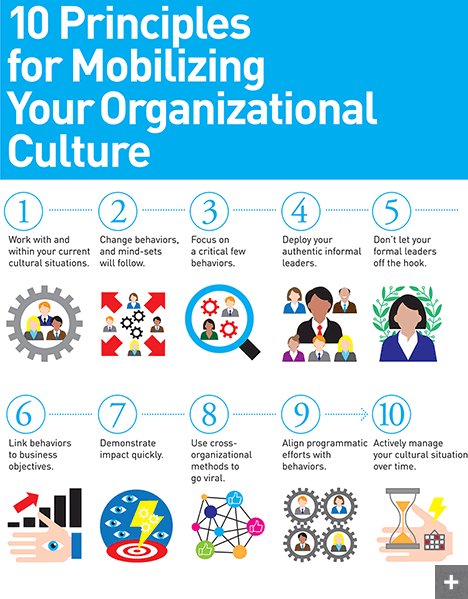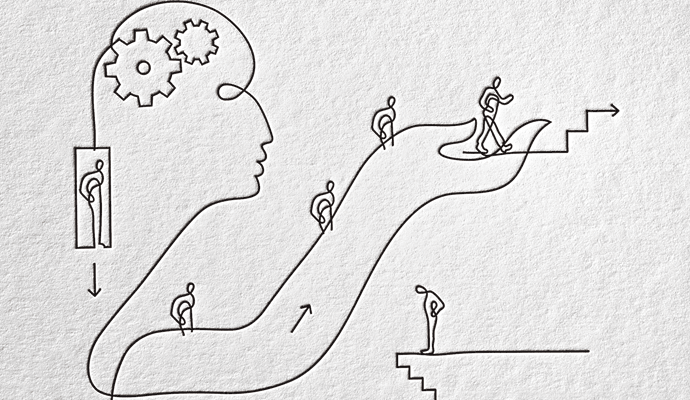10 principles of organizational culture
Companies can tap their natural advantage when they focus on changing a few important behaviors, enlist informal leaders, and harness the power of employees’ emotions.

How often have you heard somebody — a new CEO, a journalist, a management consultant, a leadership guru, a fellow employee — talk about the urgent need to change the culture? They want to make it world-class. To dispense with all the nonsense and negativity that annoys employees and stops good intentions from growing into progress. To bring about an entirely different approach, starting immediately.
These culture critiques are as common as complaints about the weather — and about as effective. How frequently have you seen high-minded aspirations to “change the culture” actually manage to modify the way that people behave and the way in which they work? And how often have you seen noticeable long-term improvements?
If the answer to these last two questions is “rarely,” it wouldn’t surprise us. We don’t believe that swift, wholesale culture change is possible — or even desirable. After all, a company’s culture is its basic personality, the essence of how its people interact and work. However, it is an elusively complex entity that survives and evolves mostly through gradual shifts in leadership, strategy, and other circumstances. We find the most useful definition is also the simplest: Culture is the self-sustaining pattern of behavior that determines how things are done.
Made of instinctive, repetitive habits and emotional responses, culture can’t be copied or easily pinned down. Corporate cultures are constantly self-renewing and slowly evolving: What people feel, think, and believe is reflected and shaped by the way they go about their business. Formal efforts to change a culture (to replace it with something entirely new and different) seldom manage to get to the heart of what motivates people, what makes them tick. Strongly worded memos from on high are deleted within hours. You can plaster the walls with large banners proclaiming new values, but people will go about their days, right beneath those signs, continuing with the habits that are familiar and comfortable.
But this inherent complexity shouldn’t deter leaders from trying to use culture as a lever. If you cannot simply replace the entire machine, work on realigning some of the more useful cogs. The name of the game is making use of what you cannot change by using some of the emotional forces within your current culture differently.
Three dimensions of corporate culture affect its alignment: symbolic reminders (artifacts that are entirely visible), keystone behaviors (recurring acts that trigger other behaviors and that are both visible and invisible), and mind-sets (attitudes and beliefs that are widely shared but exclusively invisible). Of these, behaviors are the most powerful determinant of real change. What people actually do matters more than what they say or believe. And so to obtain more positive influences from your cultural situation, you should start working on changing the most critical behaviors — the mind-sets will follow. Over time, altered behavior patterns and habits can produce better results.
You may be asking: If it is so hard to change culture, why should we even bother to try? Because an organization’s current culture contains several reservoirs of emotional energy and influence. Executives who work with them can greatly accelerate strategic and operating imperatives. When positive culture forces and strategic priorities are in sync, companies can draw energy from the way people feel. This accelerates a company’s movement to gain competitive advantage, or regain advantages that have been lost.
Research shows that companies that use a few specific cultural catalysts — that is to say, those that use informal emotional approaches to influencing behavior — are significantly more likely to experience change that lasts. Of the companies that reported consciously using elements of their culture in Strategy&’s 2013 Global Culture & Change Management Survey, 70 percent said their firms achieved sustainable improvement in organizational pride and emotional commitment. That compares with 35 percent for firms that didn’t use culture as a lever. Although there is no magic formula, no brilliant algorithm, no numerical equation that will guarantee results, we have gleaned some valuable insights through decades of research and observation at dozens of enterprises, including some of the most successful companies in the world. By adopting the following principles, your organization can learn to deploy and improve its culture in a manner that will increase the odds of financial and operational success.
1. Work with and within your current cultural situations. Deeply embedded cultures cannot be replaced with simple upgrades, or even with major overhaul efforts. Nor can your culture be swapped out for a new one as though it were an operating system or a CPU. To a degree, your current cultural situation just is what it is — and it contains components that provide natural advantages to companies as well as components that may act as brakes. We’ve never seen a culture that is all bad, or one that is all good. To work with your culture effectively, therefore, you must understand it, recognize which traits are preeminent and consistent, and discern under what types of conditions these traits are likely to be a help or a hindrance. Put another way, there’s both a yin and a yang to cultural traits.
For example, a European pharmaceutical company with a solid product development pipeline had a tendency to be inward-looking. It had great execution capabilities and an excellent record of compliance with regulators around the world. However, when new products were ready to be launched, the company had a hard time marketing them to physicians and healthcare providers. Rather than bemoaning the company’s ingrained insularity — for example, its collective tendency to value the opinions of internal colleagues more than those of outside experts — the leaders decided to use this feature of its culture to its advantage. They set up a program through which employees were acknowledged and rewarded by colleagues for “going the extra mile” to support customers. By recognizing a new kind of internal authoritativeness, the company tapped a powerful emotional trigger already in place, and engendered a new (and strategically important) behavior in its sales force.
2. Change behaviors, and mind-sets will follow. It is a commonly held view that behavioral change follows mental shifts, as surely as night follows day. This is why organizations often try to change mind-sets (and ultimately behavior) by communicating values and putting them in glossy brochures. This technique didn’t work well for Enron, where accounting fraud and scandal were part of everyday practice, even as the company’s espoused values of excellence, respect, integrity, and communication were carved into the marble floor of the atrium of its global headquarters in Houston. In reality, culture is much more a matter of doing than of saying. Trying to change a culture purely through top-down messaging, training and development programs, and identifiable cues seldom changes people’s beliefs or behaviors. In fact, neuroscience research suggests that people act their way into believing rather than thinking their way into acting. Changes to key behaviors — changes that are tangible, actionable, repeatable, observable, and measurable — are thus a good place to start. Some good examples of behavior change, which we’ve observed at a number of companies, relate to empowerment (reducing the number of approvals needed for decisions), collaboration (setting up easy ways to convene joint projects), and interpersonal relations (devising mutually respectful practices for raising contentious issues or grievances).
Neuroscience research suggests that people act their way into believing rather than thinking their way into acting.
A telecommunications company was seeking to improve its customer service. Rather than trying to influence mind-sets by, for example, posting signs urging employees to be polite to disgruntled customers, or having employees undergo empathy training, the company focused on what psychologists call a “precursor behavior” — a seemingly innocuous behavior that reliably precedes the occurrence of problem behavior. Leaders had noticed that poor teaming led to poor customer service, so the company rolled out a plan to encourage better and more effective teaming within call centers. To accomplish this, they set up regular design sessions for improving practices. When employees felt they were part of a happy team, and sensed a greater level of support from colleagues, they began treating their customers better.
In another example, a resources company in the Middle East was seeking to make its workplace safer. Rather than erect placards threatening workers with consequences, the company focused on a relatively basic precursor behavior: housekeeping. It organized a litter drive. Picking up trash as a team helped employees take greater pride in the workplace, which engendered a greater sense of care for fellow employees and made them more likely to speak up when they noticed an unsafe situation. Changed behavior, changed mind-set.
3. Focus on a critical few behaviors. Conventional wisdom advocates a comprehensive approach — everybody should change everything that’s not perfect! But companies must be rigorously selective when it comes to picking behaviors. The key is to focus on what we call “the critical few,” a small number of important behaviors that would have great impact if put into practice by a significant number of people. Discern a few things people do throughout the company that positively affect business performance — for example, ways of starting meetings or talking with customers. Make sure those are aligned with the company’s overall strategy. Also check that people feel good about doing these things, so that you tap into emotional commitment. Then codify them: Translate those critical behaviors into simple, practical steps that people can take every day. Next, select groups of employees who are primed for these few behaviors, those who will respond strongly to the new behaviors and who are likely to implement and spread them.
At an Asian banking company, rapid inorganic growth had led to diverse ways of working across different units and geographies. To focus on improving teaming, customer outcomes, and the ability to realize synergies, the CEO and leadership embarked on a culture-led evolution program. They targeted just three critical behaviors: taking extra steps to delight customers, valuing performance over seniority, and backing up and supporting one another. They then converted these three general behaviors into specifics for each part of the company. Delighting customers, for instance, was translated into frontline staff collaborating with other colleagues to solve client problems and prioritizing the implementation of process improvements that affected customer outcomes. For all three behaviors, leadership recognized and celebrated examples in which people made an extraordinary effort. Senior leaders acted as role models, explicitly modeling these three new behaviors. The company also identified influential frontline, client-facing employees who could demonstrate these new behaviors in action.
4. Deploy your authentic informal leaders. Authority, which is conferred by a formal position, should not be confused with leadership. Leadership is a natural attribute, exercised and displayed informally without regard to title or position in the organizational chart. Because authentic informal leaders, who are found in every organization, are often not recognized as such, they are frequently overlooked and underused when it comes to driving culture. It is possible to identify such leaders through interviews, surveys, and tools such as organizational network analysis, which allow companies to construct maps of complex internal social relations by analyzing email statistics and meeting records. Once identified, these leaders can become powerful allies who can influence behavior through “showing by doing.” In fact, when companies map out their organizations, they can identify leaders who exhibit different core leadership strengths (see “Four Types of Authentic Informal Leaders”).
Four Types of Authentic Informal Leaders
Every organization has people who influence and energize others without relying on their title or formal position in the hierarchy to do so. We call them “authentic informal leaders.” They are a powerful resource in spreading a critical few behaviors from the bottom up. Among the many types of informal leaders present in organizations, the following are seen most frequently.
Pride builders are master motivators of other people, and catalysts for improvement around them. Often found in the role of line manager, they understand the motivations of those with whom they work. They know how to foster a sense of excellence among others. They can be found at every level of a hierarchy; some of the most effective pride builders are close to the front line, where they can interact directly with customers as well as employees. Pride builders often have powerful insights about the culture and about what behaviors are likely to lead to improvement.
Exemplars are role models. They bring vital behaviors or skills to life, and others pay attention to them. They are well respected and are effective peer influencers in the middle and senior management cohorts.
Networkers are hubs of personal communication within the organization. They know many people, and communicate freely and openly with them. They serve as links among people who might not otherwise share information or ideas. If you want to see an idea travel virally through an enterprise, enlist your networkers.
Early adopters enthusiastically latch onto and experiment with new technologies, processes, and ways of working. Involve them in your performance pilots, or whenever you are trying to demonstrate impact quickly.
At one major oil company, an informal leader named Osama became known as the “turbo-collaborator.” His role gave him very little formal influence. But when he began working at the refinery, he walked the plant with the engineers, maintenance technicians, and operators, and took copious notes. As a result, he knew everyone and developed relationships across disciplines. Whenever somebody wanted to know how the place really worked, they would speak to Osama — who would either have the answer in his notebook or know precisely the right person to ask. When the company formed a buddy program between operations and maintenance aimed at using greater collaboration to improve plant reliability, it knew it needed Osama at the heart of it. He connected people, defined templates to encourage collaboration, and captured success stories. Identifying, engaging, and nurturing such informal leaders allows companies to harness their talents and further the company’s transformation efforts.
5. Don’t let your formal leaders off the hook. Most organizations tend to shunt culture into the silo of human resources professionals. But leaders in all parts of the company are critical in safeguarding and championing desired behaviors, energizing personal feelings, and reinforcing cultural alignment. The signaling of emotional commitment sets the tone for others to follow. If staff members see a disconnect between the culture an organization promulgates and the one its formal leadership follows, they’ll disengage quickly from the advertised culture and simply mimic their seniors’ behavior. The people at the top have to demonstrate the change they want to see. Here, too, the critical few come into play. A handful of the right kind of leaders have to be on board to start the process.
When Jim Rogers was CEO of GE Motors in Fort Wayne, Ind., he became frustrated because his senior leadership group of more than 15 leaders seldom functioned together as a “real team.” As described by Jon Katzenbach and Douglas K. Smith in The Wisdom of Teams: Creating the High-Performance Organization (Harvard Business School Press, 1993), a real team is one with a high level of emotional commitment; the leadership role shifts easily among the members depending on their skills and experience and the challenges of the moment, rather than on any hierarchical positions. Team members hold one another accountable for the quality of their collective work. Interestingly, at GE Motors the senior leadership group members often demonstrated real team capabilities in running their individual business units and functions. So Rogers decided to find ways to break them into subteams of three or four members to address specific cross-organizational issues facing the larger group. Over time, he mixed the subgroupings to match emerging issues. By working in different subgroup settings, the executives developed camaraderie, which in turn improved the effectiveness of the group as a whole.
6. Link behaviors to business objectives. When people talk about feelings, motivations, and values — all of which are vital elements of strong cultures — the conversation can often veer into abstractions. It may then range far afield of what it takes to succeed in the market. Too many employees walk away from culture-focused town halls or values discussions wondering how the advice on how to be a better person actually translates into the work they do. To avoid this disconnect, offer tangible, well-defined examples of how cultural interventions lead to improved performance and financial outcomes. Select behaviors that are aimed specifically at improving business performance and can be measured over time.
An oil company’s drive to reduce maintenance costs at an industrial installation highlights the importance of such an approach. The critical few behaviors included empowerment and good decision making. One of the company’s exemplars (employees who lead by example) decided it would be a smart move to make costs visible to workers. So he placed price tags on various pieces of machinery. These cues inspired behavioral changes related to decisions about whether to repair or replace equipment. Workers and managers began to recommend fixing expensive equipment rather than replacing it. The company celebrated and publicized cost savings identified by employees. The behaviors led to a change in focus and mind-set. When an employee noticed that fans were cooling the machinery during the winter, he felt empowered to call it out, and ask whether it was necessary to do so. It turned out that it wasn’t — and the company saved US$750,000 annually in power costs as a result.
7. Demonstrate impact quickly. We live in an age of notoriously short attention spans. That applies as much to organizational culture as it does to people’s media consumption habits. When people hear about new high-profile initiatives and efforts, and then don’t see any activity related to them for several months, they’ll disengage and grow cynical. That’s why it is extremely important to showcase the impact of cultural efforts on business results as quickly as possible. One effective method of doing so is to stage performance pilots — that is, high-profile demonstration projects. Pilots are relatively low-risk efforts that introduce specific behaviors that can then be evaluated and assessed. They often rely on a dashboard that defines desired impacts, the tactics used, and the specific metrics to be employed.
When Bell Canada first explored using new behaviors at the front line to improve its customer service and profitability, there were many more skeptics than believers within the leadership ranks. There simply wasn’t any numerical proof that the tactics would work. So CEO Michael Sabia decided to set up a pilot test in a sales unit near Toronto. The sponsors of the test blocked out a tight time frame of eight months, and developed realistic ways of measuring behavior change, customer reactions, and actual sales and margin performance. Armed with positive results in these areas — a 29 percent increase in customer satisfaction in retail stores, a 31 percent increase in revenue per call at call centers — the company went on to accelerate the expansion of these efforts across the front line in different geographies, functions, and businesses.
8. Use cross-organizational methods to go viral. Ideas can spread virally across organizational departments and functions, as well as from the top down and from the bottom up. One powerful way to spread ideas is through social media: blogs, Facebook or LinkedIn posts, and tweets — not from senior management, but from some of the authentic informal leaders mentioned in Principle 4.
By now it is well established that social media can be more effective at spreading information, news, and music than traditional modes of distribution. The same holds with critical behaviors. People are often more receptive to changes in “the way we do things around here” when those changes are recommended or shared by friends, colleagues, and other associates. This kind of credible social proof is more compelling than similar testimonials from someone whose job it is to sell something.
Just as there is an art to making content go viral, there’s a craft to making behavior go viral. For example, in a model that we have tested successfully in several situations, a company starts with a few carefully chosen groups of 12 to 15 informal leaders in three or four different parts of the business. After several weeks, an additional 10 to 15 groups of informal leaders are set up in every business unit. After about three months, the existing groups are encouraged to expand and bring in new people. After another three to six months have passed, the groups become more autonomous, allowed to control their own expansion. Meanwhile, the company facilitates connections among groups to share learning and insights. As behavior spreads, company leaders see increased performance as well as peer and leadership recognition.
9. Align programmatic efforts with behaviors. We’ve emphasized the role that informal leaders can play in helping ideas go viral. But it’s also important to match the new cultural direction with existing ways of doing business. Informal mechanisms and cultural interventions must complement and integrate with the more common formal organization components, not work at cross-purposes. By providing the structure in which people work — through disciplines such as organization design, analytics, human resources, and lean process improvement — the formal organization provides a rational motivation for employee actions, while the informal organization enables the emotional commitment that characterizes peak performance.
The U.S. Marine Corps provides a classic example of integrating formal and informal leadership efforts. The “rule of three” dictates how the Marines design their organizations and projects and how they execute in a hierarchy. (Three squads form into one of three divisions, which form one of three battalions.) The formal leaders of those units are expected to know the intent of the officer two levels above them — and to call out any order or situation they perceive to be incoherent or in conflict with that intent. But there are also informal leaders: Each of the four members of a frontline rifle team is prepared (and expected) to take the lead whenever the formal leader is disabled or loses the high-ground position. This means that the informal leaders also need to know the intent of that officer two levels above. Integrating informal norms with the formal structures helps enable the timely battlefield adjustments that have served the Marine Corps well for more than 200 years.
10. Actively manage your cultural situation over time. Companies that have had great success working with culture — we call them “culture superstars” — actively monitor, manage, care for, and update their cultural forces. Why? As we noted at the outset, when aligned with strategic and operating priorities, culture can provide hidden sources of energy and motivation that can accelerate changes faster than formal processes and programs. Even if you have a highly effective culture today, it may not be good enough for tomorrow.
Southwest Airlines stands as an example of a battle-tested company in which culture has been managed over time. Famous for its long-term success in an industry where even the largest players routinely fail, Southwest for 40 years has been energized by a deep sense of pride among all employees. Southwest has found that constructing an environment that puts its employees first — above customers and owners — fosters a sense of emotional commitment and pride that delivers excellent customer service. But at Southwest, the work on culture is never completed. Just as the airline’s strategy, tactics, and technologies have evolved to cope with a changing external environment, specific HR practices, including informal behaviors, have shifted over time.
Living in Your Culture
Although challenging, multidimensional, and often difficult to deal with, a company’s cultural situation constitutes a powerful set of emotional resources. As is the case with other resources — human, technological, financial — it is incumbent upon leaders to strive to get the most value out of it.
To a degree, culture can be compared to natural forces such as winds and tides. These elements are there in the background, sometimes unnoticed, sometimes obvious. Endowed with immense power, they can waylay plans and inhibit progress. They can’t really be tamed or fundamentally altered. But if you respect them and understand how to make the most of them, if you work with them and tap into their hidden power, they can become a source of energy and provide powerful assistance.
The best way to start is to ask yourself a series of questions. What are the most important emotional forces that determine what your people do? What few behavior changes would matter most in meeting strategic and operational imperatives? Who are the authentic informal leaders you can enlist? And what can you and your fellow senior leaders do differently to signal and reinforce those critical behaviors?
Of course, you shouldn’t plan for dramatic results overnight. Expect an evolution, not a revolution. One of the challenges of working with culture is that, as we’ve noted, it changes gradually — often too slowly for leaders facing fast-moving competitors. That’s the bad news. The good news? If you approach culture with respect and intelligence, as a milieu in which you and your enterprise live, you can use it to accelerate your competitive momentum. There’s no better time than the present to start.
Reprint No. 16105
Author profiles:
- Jon Katzenbach is an acclaimed advisor to executives for Strategy&, PwC’s strategy consulting group. He is a managing director with PwC US, based in New York, and founder of the Katzenbach Center, Strategy&’s global institute on organizational culture and leadership. He is a best-selling author on organizational culture, leadership, and teaming; his books include The Wisdom of Teams (with Douglas K. Smith; Harvard Business School Press, 1993) and Leading Outside the Lines (with Zia Khan; Jossey-Bass, 2010).
- Carolin Oelschlegel is a director of the Katzenbach Center for Strategy&. She leads the global operations of the center and advises clients around the world on culture and leadership topics. Based in San Francisco, she is a director with PwC US.
- James Thomas is a thought leader in organizational culture with Strategy&. He is the Middle East lead of the Katzenbach Center and an expert in culture and organizational topics. Based in Dubai, he is a partner with PwC Middle East.
- Also contributing to this article were Strategy& specialists Varya Davidson (partner with PwC Australia), Kenji Mitsui (partner with PwC Japan), Henning Hagen and Rutger von Post (principals with PwC US), and Shona Especkerman (senior manager with PwC Malaysia).





